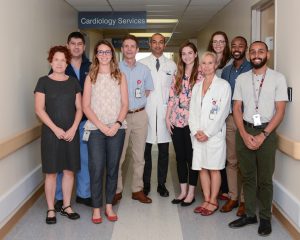
Shah Lab
Coronary heart disease is the largest cause of death amongst veterans. Although cardiac rehabilitation is a life-saving program for patients with heart disease, few veterans (<20%) are able to attend these programs because of the distance from their home to the rehab facility, the cost of the program, or other reasons.
Amit Shah, MD, MSCR, is a Staff Cardiologist at the Atlanta VA who is working to address these barriers to more effectively deliver cardiac rehab for veterans with a multidisciplinary team co-led by Dr. Arash Harzand, MD. The team includes specialists in health psychology and nutrition. They started a new program in 2015 involving smartphone technologies and home-based cardiac rehabilitation in which participants were coached on increasing exercise, reducing stress, and eating healthier over the course of 12 weeks. Initial findings indicated that this program was feasible and effective in improving fitness and blood pressure to levels similar to traditional programs. They found that even in cases where veterans were new to smartphones or fitness trackers, many engaged with the program and learned how to use the technology.
After this initial success, this program gained additional funding by the VA Center for Innovations and Office of Rural Health, and was started in 5 other VA facilities across the country. Their goal is to understand the impact of this program at improving the reach and delivery of cardiac rehabilitation throughout the VA. Early findings indicate that more veterans are getting into cardiac rehabilitation, and overall their risk factor profile is reducing; veterans are exercising more, smoking less, eating healthier, are more confident in their health, and losing weight. Preliminary analyses from Atlanta suggest an over 50% reduction in hospitalization rates; costs of care are also reduced in these individuals.
These studies exemplify how research can uncover new strategies of veteran-centered care to improve outcomes. Early findings from this research program were published in the November 1, 2018 issue of the American Journal of Cardiology available online at https://www.ajconline.org/article/S0002-9149(18)31500-5/abstract.